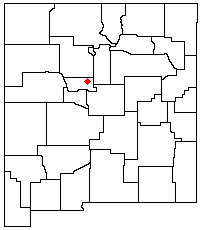Sandia–Manzano Mountains facts for kids
Quick facts for kids Sandia–Manzano Mountains |
|
|---|---|
| Highest point | |
| Peak | Sandia Crest |
| Elevation | 10,678 ft (3,255 m) |
| Prominence | 4,201 ft (1,280 m) (crest) |
| Geography | |
| Country | United States |
| State | New Mexico |
| Parent range | Fault block of the Albuquerque Basin |
| Borders on | Albuquerque, NM |
The Sandia–Manzano Mountains are a large group of mountains in central New Mexico. They form the eastern edge of the middle Rio Grande valley. These mountains are a beautiful background for Albuquerque, the biggest city in New Mexico.
These mountains offer many fun activities. You can go skiing in winter or enjoy cool summer hiking and picnics. This is a nice change from the hot desert areas below. The whole mountain chain has three main parts from north to south: the Sandia Mountains, the Manzanita Mountains, and the Manzano Mountains. The Manzanita Mountains are lower hills that connect the Sandias and Manzanos.
Exploring the Sandia–Manzano Mountains
The Sandia–Manzano Mountains are often seen as the most northern major mountain range in the Basin and Range Province. There's a big gap of lower grasslands and savanna between these mountains and the Sangre de Cristo Mountains to the north. The weather conditions also change a lot between these two areas.
Unique Plants and Animals
Many types of plants, animals, and insects live in the Sandia–Manzano Mountains. These species are also common in mountains further south. However, they become less common in mountains to the north.
- Quercus turbinella (Desert Scrub Oak)
- Opuntia engelmannii (Prickly Pear Cactus)
- Aloysia wrightii (Wright's Beebrush)
- Western Diamondback Rattlesnake
At higher parts of the Sandia–Manzano Mountains, you'll find plants and animals typical of the Rocky Mountains. This shows how the climate changes with elevation.


